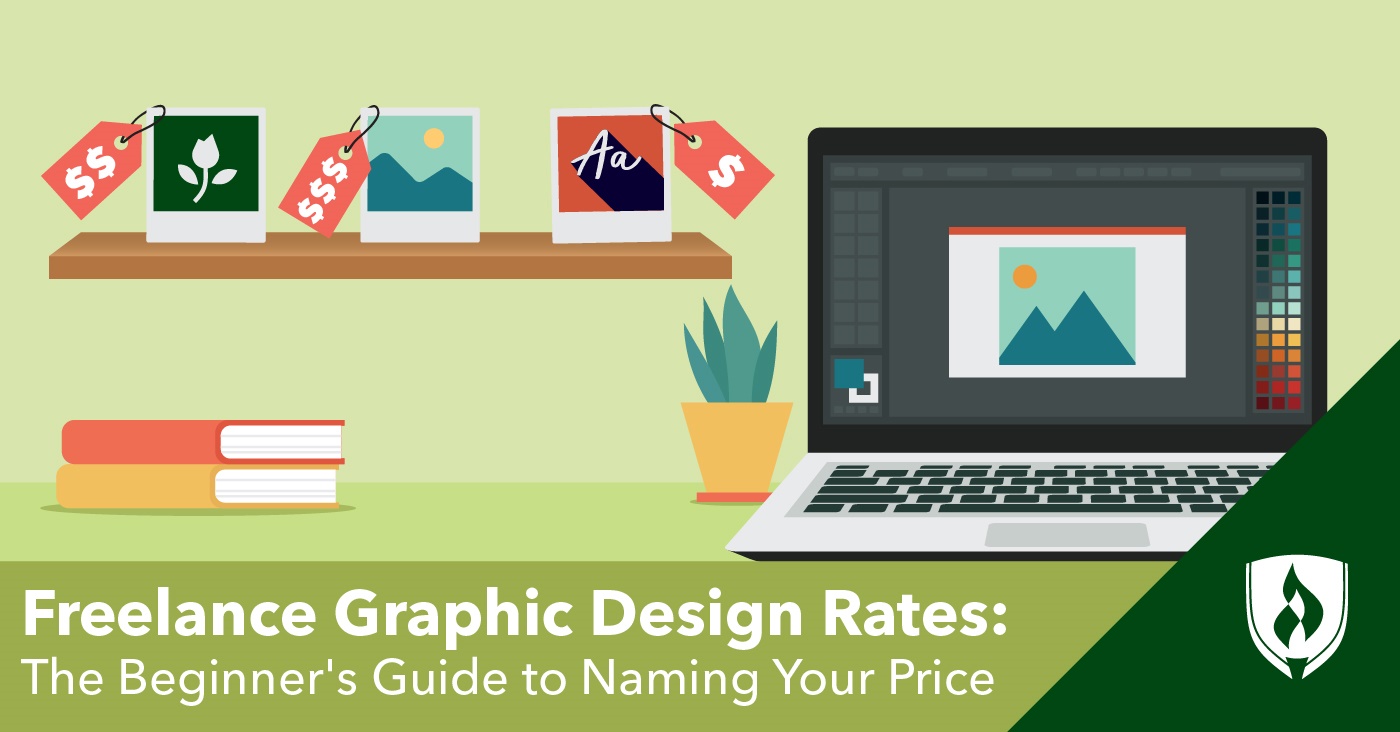Freelance Graphic Design Rates: The Beginner's Guide to Naming Your Price
By Carrie Mesrobian on 06/07/2021

You’ve studied hard, learned the skills and software, and are ready to start taking on some real work as a graphic designer. While freelance work sounds like a great way to raise your profile, develop your portfolio and start adding to your bank account, you might be struggling for answers surrounding one key question: What do I charge for my work?
Don’t feel dismayed! This is a very common question for all freelance professionals, especially those who are just entering the market. It’s not easy trying to determine an appropriate dollar figure for the value of your time, and many new freelancers have been burned as they learn the ropes. That’s why we’ve rounded up some experienced graphic designers to offer insight on how to think about what goes into your work and how to set your rates accordingly.
How to determine your rates for graphic design projects
When entering new territory, it’s always a good thing to get the lay of the land and find what other graphic designers are charging their clients. One way is to look for other freelance designers who are already in business; many list rates and pricing for projects directly on their websites.
If you’d like to go deeper, you can go directly to the source and ask agencies what they’d charge for a particular project. There can be a difference between what independent designers charge and those who work at an established agency.
“What I do to figure where I should price myself is find several businesses and designers who I would comfortably rank as similar to myself in proficiency,” explains Kristine Daub, graphic designer and founder of byCurated. “Once I’ve got about ten, I will phone them and request pricing.” This information gives Daub a good range in which to set her own rates.
Roberta Morris, founder and creative director of Leave It To ‘Berta, offers these two tips for new designers looking to set their rates.
“Join trade organizations and take advantage of their resources,” Morris suggests. “Another way to calculate pricing is to figure out an average annual salary for the work and add 20 percent to cover business expenses and higher taxes.”
Should I bill hourly or on a per-project basis?
Among graphic designers, there are many opinions on the benefits of charging by the hour or by the project. For some, charging per project makes more sense.
“When calculating my rate on a project, we always do a flat rate, and it is calculated project by project,” explains Jacy Valeras, founder of Platinum Circle Media. “I find that with a creative project, hourly can be difficult to manage.”
Graphic designer Jon Beres also prefers to work with fixed, flat rates.
“First, it gives transparency between the client and myself, so each of us knows upfront what we are paying or getting paid,” Beres says. “Second, a fixed price will give me the ability to build in padding for revisions. I always provide unlimited revisions within the scope of each project. This is important because it guarantees the client will be happy with the results.”
For others, an hourly rate works better. This might involve experimenting on your part to get a sense of what types of projects will ask of you in terms of time.
“Since we have done our services hundreds of times, we have gotten it down a science,” says Andrew Weisz, CEO of Finden Marketing. “A logo takes X amount of time, so it should be priced at X; a branding package takes X amount of time, so it should be priced at X.”
Factoring your time into your pricing
Getting a sense of how long it takes to complete a particular design task, however, is something that many designers learn over time, sometimes with varying degrees of success.
Stephanie Carter, COO of Oozle Media, often hires graphic designers who have been freelancers.
“Common things I hear are that they forgot to factor in the time it takes to actually attract, pitch and lockdown new contracts or clients,” Carter reports. “We also hear things like, 'I didn't know how much taxes were going to take out.’”
It’s important for new graphic designers respect their own time and the scope of the job by being clear about the scope of the job. Details like how many revisions will be included, how much time you’ll need for discovery and research, and travel time and expenses should all be considered before naming a rate.
“We also remind our designers to set the rules of the game,” Carter adds. “Not laying out boundaries upfront will severely eat into your profitability.”
Aaron Whittaker, director of demand generation at Thrive Agency, recommends establishing a payment structure to keep both you and the client on track in terms of expectation and cost.
“One third upfront, one third on the final design approval and one third after delivery of the work,” Whittaker explains. “A nice simple contract tag line in the agreement can be something like ‘All rights remain with the designer until receipt of the final project payment.’”
There are also aspects to a designer’s pricing that go beyond time, according to Mark Des Cotes, graphic designer and host of Resourceful Designer podcast.
“One of the biggest mistakes young designers make is pricing based on the product instead of the service they deliver,” Des Cotes explains. But the designer’s service is more than just a particular product like a poster or brochure, and Des Cotes encourages designers to consider other factors when they set prices.
“Things like discovery, strategy or presentation sessions with the client, research into the client’s industry, competition and target market,” Des Cotes adds. “Designers need compensation for this non-design time and should include it in their pricing since it is all part of the overall project.
Graphic design for free: Is it ever worth doing?
For many years, creative industries like graphic design have adhered to a portfolio model, where newcomers to the field provide uncompensated work in exchange for building their own portfolios and gaining “exposure.” This creates a dilemma for designers just starting out: How do you build your portfolio if you don’t have a job that helps you build one?
It’s helpful to remember that a creative portfolio can be built in many ways. If you have a cause or nonprofit that needs assistance with design, doing work for a cause you believe in can be a way to justify the lack of compensation.
Morris believes that the recent rise online gig work platforms, where all types of freelance services are offered for as low as $5, complicates the pricing question even further.
“With the advent of Fiverr and other platforms like it, there is even more pressure put on the pricing conversation,” Morris says. “Just because it doesn’t take forty hours to design a logo doesn’t mean it’s worth less. It’s the creativity and thinking that goes into it that’s the real value.”
Tony Ham, founder of Tony Ham Creative, has also seen the impact of freelance platforms and encourages designers to think of what they offer differently.
“It is important to emphasize to a potential client that your services are much more than just executing a design or task,” Ham explains. “Rather, you are providing design experience to influence the final product that matches the client's vision and is able to communicate properly to their audience. Your cost is not just the cost of doing the work but also your experience, skill, ability to communicate and interpret.”
Above all, Designer Jon Beres encourages new designers to know their value.
“If I could give any advice to people first entering this industry, it would be to know what you’re worth and stick to it,” Beres says. “If clients don’t want to pay it, that’s okay! Others will come.”
Looking for more advice from graphic design professionals?
While having the skill set needed to start taking on freelance graphic design projects is certainly a great foundation to build upon, there’s a lot to learn in order to be an effective designer. If you’re looking to continue rounding out your knowledge of this field, check out our article “What I Wish Someone Told Me BEFORE Becoming a Graphic Designer…”.
EDITOR’S NOTE: This article was originally published in 2015. It has since been updated to include information relevant to 2021.




